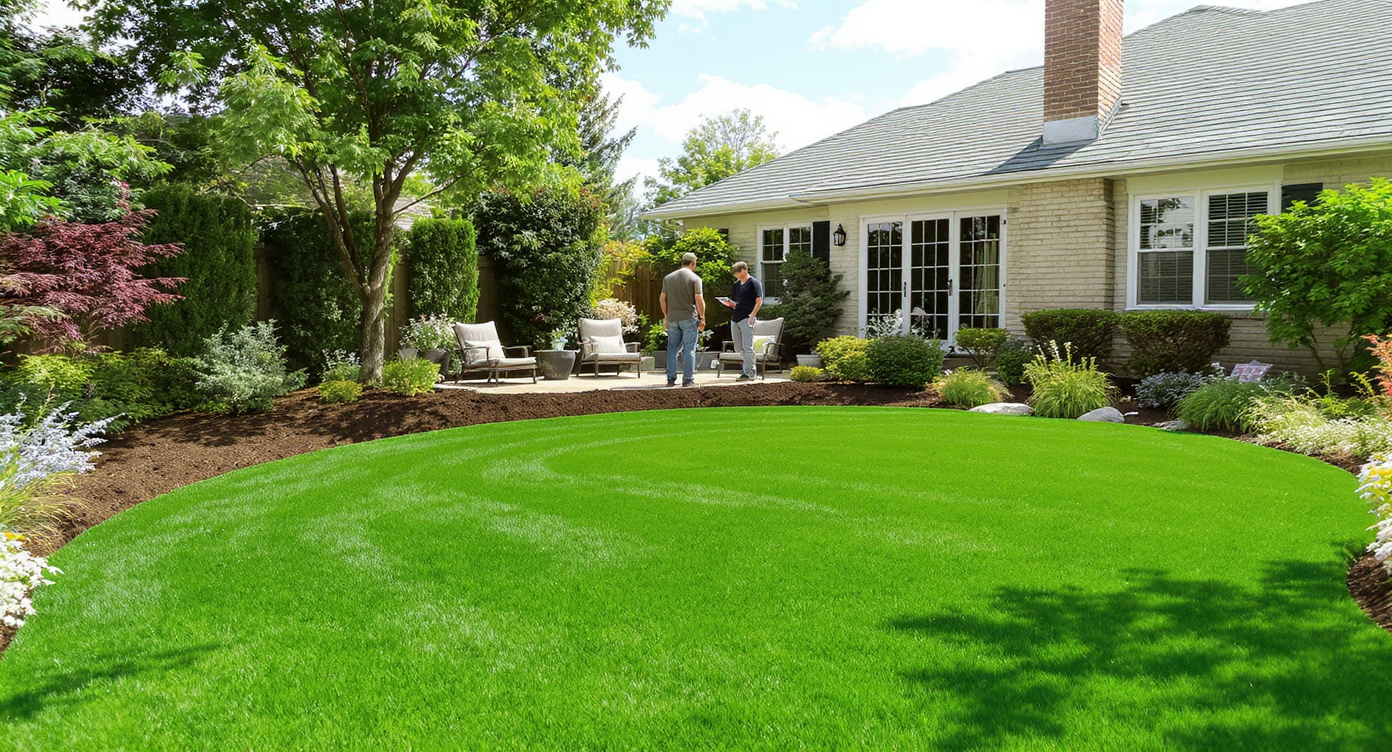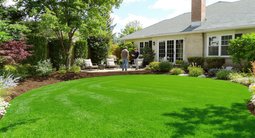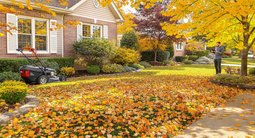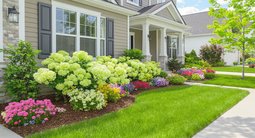TL;DR
For a backyard makeover with new turf, clear weeds before you level and sod—either by smothering (cardboard + mulch or solarization) or, if you choose herbicides, by spraying actively growing weeds 7–14 days before mowing. Keep soil covered, establish the sod in 2–3 weeks with deep watering, and use pre-emergent in the next season to prevent a fresh flush.
60–90 days to a resilient lawn reset: introduction

Effective yard clearing methods before turf: solarization, smothering, and leveling for optimal lawn health.
The fastest route to a healthy lawn is a clean reset. That means killing or smothering weeds first, leveling second, then laying sod quickly so bare soil isn’t sitting there inviting new germination. Whether you prefer chemical-free landscaping ideas or a strategic, one-time non‑selective application, the sequence matters. For best results, spray or smother while weeds are lush, wait for full die‑back, remove debris, grade, and install turf within 24–48 hours. At a glance: - 4–6 weeks: solarization (clear plastic) in hot weather can sterilize the top seed bank. - 1–2 layers of cardboard + 3–4 inches of mulch smother annuals and weaken many perennials. - 7–14 days: non‑selective herbicide needs time to translocate from leaves to roots; spray before mowing. - 1–3 weeks: expect a fresh flush after tilling or grading—time a follow‑up pass before you sod. - 2–3 weeks: sod typically knits in with deep, less‑frequent watering. - Next season: apply pre‑emergent at soil 50–55°F to block new weeds. Try your own path, patio, or planting layout on a photo of your yard in ReimagineHome.ai.
30–50% of household water goes outdoors: why lawn design is shifting

Shifting lawn design toward water efficiency and sustainability with native planting and smart irrigation.
Lawns are being reimagined for water efficiency, wildlife, and sanity. If a traditional grass carpet still fits your curb appeal goals, great—just design it like any outdoor room. Keep the lawn footprint purposeful (play, pets, entertaining) and frame it with low‑maintenance hardscaping design: stone patio zones, walkway ideas, and privacy planting that reduce mowing edges and weed pressure. A water‑smart approach doesn’t have to look wild. If you’re curious about blending modern landscaping ideas for small front yards with meadow-inspired edges, start with this watersmart landscaping and curb appeal guide. It shows how to use structure—edging, terrace levels, and outdoor lighting design—to make drought‑tolerant planting feel tidy and intentional.
Anecdote
A homeowner in a coastal town laid cardboard over a weedy side yard, topped it with 4 inches of wood chips, and cut crisp pockets for rosemary, bay, and lavender. Six months later, the chips had settled, the cardboard was nearly gone, and the weeds were, too. The adjacent lawn, now half its original size, looked smarter—not smaller.
3 proven ways to clear a yard before new turf (and when to use each)

Three proven yard clearing methods with timing and coverage choices for optimal turf preparation.
Clearing weeds before new turf is about coverage, timing, and keeping the soil protected between steps. Choose the path that fits your climate, timeline, and comfort level.
4–6 weeks of solarization can superheat soil to 110–140°F
In peak sun, stretch clear plastic tight across moist soil, trench the edges, and leave it sealed. Solarization weakens many perennials and wipes out a large portion of the weed seed bank near the surface. After removal, rake, level, and sod quickly.
1–2 layers of cardboard plus 3–4 inches of mulch smother annual weeds
Overlap seams 6 inches so light can’t sneak in. This chemical‑free landscaping idea starves weeds while improving soil as the cardboard decomposes in 3–6 months. It’s excellent for creating shrub or perennial beds around a smaller, right‑sized lawn. For stubborn grasses with deep crowns (think pampas or running bermuda), see these nine proven removal techniques to fully stop the roots before you replant.
7–14 days of translocation are required after non‑selective spraying
If you decide to use a non‑selective herbicide, spray when weeds are tall and actively growing, and do it before mowing so there’s more leaf surface. Wait a full week or two for complete die‑back to the roots, then rake, level, and install sod. Follow label precautions and keep pets and people off treated areas until dry.
1–3 weeks after tilling, expect a fresh weed flush
Soil disturbance brings buried seed to the party. If you till or regrade, plan a follow‑up: either a shallow flame pass, a boiling‑water/steam treatment for cracks and edges, or a timed spray. Then lay turf within 24–48 hours so the seed bank doesn’t get another window. For a design-level overview of sequencing paths, patios, and plant beds, study this practical landscape planning guide.
1 upload = dozens of AI landscape versions: how to use ReimagineHome.ai

Easily explore dozens of AI-generated landscape versions from one upload using ReimagineHome.ai.
Upload one exterior photo and let home design AI do the heavy lifting. ReimagineHome.ai is an ai landscape generator that lets you test ai backyard design ideas—lawn size, walkway geometry, stone patio shapes, even curb appeal lighting—before you move dirt. - 3 steps: upload your yard, choose landscaping styles, and generate multiple versions in minutes. - Swap materials: compare a gravel path vs. pavers, a larger patio for a fire pit, or a boulder edge vs. steel edging to keep turf from creeping. - Right‑size the lawn: explore clover, fescue, or zoysia options to crowd out weeds long‑term while keeping the look clean. - Front yard design: trial modern landscaping ideas for small front yards with low hedges for privacy planting and drought‑smart perennials that won’t overrun the walk. Alt: “Side‑by‑side visualization of a small backyard with full sod, a reduced lawn plus a stone patio, and a clover lawn framed by privacy planting, generated in ReimagineHome.ai.” Caption: “ReimagineHome.ai lets you compare lawn footprints, patio shapes, and planting structure—so you choose what to build, not just what to hope for.”
2 field-tested transformations: real-world stories from ordinary yards

Real-world yard makeovers demonstrate the power of tested clearing and turf installation methods.
A homeowner on a windy plateau tried everything but couldn’t keep a seeded lawn alive. They solarized for 5 weeks in midsummer, then installed a compact sod panel framed by a flagstone path and deep mulch beds. The key was coverage: turf down within 48 hours, plus a crisp steel edge so mulch and lawn stayed in their lanes. Two months later, the yard felt finished—and weeds were minimal. In central heat, another family plugged empire zoysia on a 12‑inch grid across a rough lawn. With consistent deep watering the first season, the zoysia thickened and shaded the soil, outcompeting most weeds. A narrow decomposed‑granite walkway curbed foot traffic across the lawn, and a small fire‑pit terrace took pressure off the grass. Sometimes the best weed control is simply designing for how you live.
Visualization Scenario
Upload your backyard photo to ReimagineHome.ai, draw a reduced lawn with a curving edge, drop in a stone patio for a grill and a narrow walkway to the gate, then compare that to a clover lawn with a straight steel edge and taller privacy planting. Choose the version that fits your watering, mowing, and entertaining habits.
5 fast answers homeowners ask before laying sod over weeds
- Q: Should I mow or spray first when resetting a weedy lawn? A: Spray first if you’re using a non‑selective herbicide—more leaf area means better uptake. Wait 7–14 days for full die‑back, then mow/rake, level, and sod. - Q: How do I clear weeds without chemicals before new turf? A: Solarize for 4–6 weeks in peak heat, or smother with 1–2 layers of cardboard plus 3–4 inches of mulch. Follow with quick grading and immediate sod so soil isn’t bare. - Q: How soon will sod establish? A: Most sod knits in 2–3 weeks with deep, infrequent watering. Avoid heavy foot traffic until roots resist a gentle tug. - Q: What about a pre‑emergent? A: Use a crabgrass pre‑emergent in the next season when soil hits roughly 50–55°F. Don’t apply pre‑emergent right before seeding. - Q: Can I just till and seed? A: You can, but expect a new weed flush 1–3 weeks after tilling. Time a second clearing step, or lay sod fast. Consider clover or a reduced‑lawn plan if you want lower maintenance long‑term.
1 photo, countless versions: visualize your home’s next chapter
Before you buy sod, map the lawn you actually need. Use hardscaping to set edges, dedicate a stone patio for gathering, and keep walkways direct so you’re not dragging heavy traffic through tender turf. Then let ReimagineHome.ai preview the look—ai yard design that helps you decide, in minutes, whether to go bigger on lawn, bolder on planting, or leaner on maintenance.
Before you rearrange a room or invest in new furniture, explore a celebrity-inspired version of your space in ReimagineHome.ai — a low-risk, high-creativity way to preview ideas before committing in real life.
.svg)

.svg)














.png)